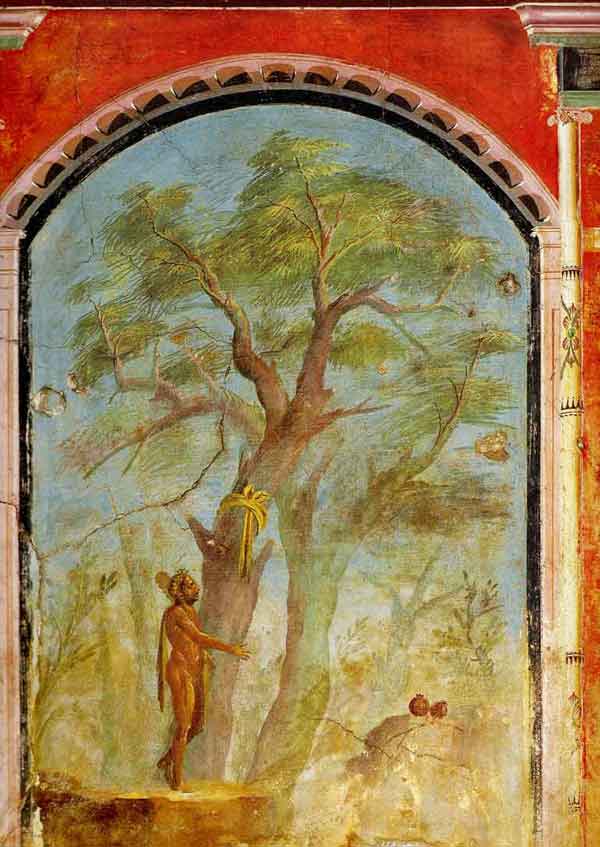

"Keto (Ceto), joined in love with Phorkys (Phorcys), mothered the youngest of the deadly Drakones (Dragon-Serpents), that one who at the gloomy great hidden limits of the earth guards the all-golden apples. Evelyn-White) (Greek epic C8th or C7th B.C.) : Heracles, Hesperian Dragon and Atlas, Athenian red-figure krater C5th B.C., The J. Source: Dictionary of Greek and Roman Biography and Mythology. He had been appointed to watch in the gardens of the Hesperides by Juno, and never slept but he was slain by Heracles and the image of the fight was placed by Zeus among the stars. He is said to have been able to assume various tones of voice, and to have been the offspring of Typhon and Echidna but he is also called a son of Ge, or of Phorcys and Ceto. The dragon, who was believed to guard the apples of the Hesperides. TYPHOEUS & EKHIDNA (Apollodorus 2.113, Hyginus Fabulae 151) Therefore, the hundred-headed serpent, whose name means "Strong Flow", might have represented dangerous sea currents. In Hesiod, the parents and siblings of Ladon represent the various dangers of the sea. It was afterwards placed amongst the stars by the gods as the Constellation Draco encircling the north pole. The creature was slain by Herakles when he was sent to recover the golden apples as one of his twelve labours.

THE DRAKON HESPERION (Hesperian Dragon) was a hundred-headed serpent named Ladon tasked with guarding the golden apples of the Hesperides and tormenting the heavens-bearing Titan Atlas. Subsequently, Heracles would be aided by the goddess Athena, for the goddess was said to have returned the Golden Apples into the care of the Hesperides after the completion of the Labour.Dragon of the West Ladon the Hesperian Dragon, Athenian red-figure amphora C5th B.C., State Hermitage Museum In the later version of the myth, Heracles of course had to hold the heavens aloft in place of Atlas, whilst Atlas stole the Golden Apples Heracles would have to then trick Atlasin to trading places again.

#THE HESPERIDES GREEK MYTHOLOGY HOW TO#
The help given by Atlas depends on the version of the story being read, either the Titan simply told Heracles how to enter the garden and get passed the Hesperides (possibly Atlas’ daughters, or Atlas did the entering of the garden himself. Heracles then sought out the help of Prometheus’ brother Atlas. Heracles firstly discovered the location of the Garden of the Hesperides by either wrestling Nereus, one of the older sea gods, or by asking the Titan Prometheusfor the information. The most famous story about the Garden of Hera sees the visit of Heracles, for the Greek hero had been tasked by King Eurystheus, as the 11th Labour, to bring back some of the Golden Apples from the garden. The Golden Apples, and the tools, were incredibly valuable and so guarding them was not left purely down to the Hesperides, and they were joined in the Garden of Hera by a hundred-headed dragon named Ladon. The Garden of Hera was home to more than just an orchard and plants though, for it was also a hiding place for many powerful tools of the gods, including Hades’ helmet of invisibility, Athena’s shield, and the sandals of Hermes. The original golden apples had been presented to Hera by the goddess Gaia, when Hera had wed Zeus and it was the Golden Apples that was said to give the golden tinge of sunsets. The Garden of Hera was a sacred place, and was famously home to the Golden Apples of Greek mythology, and possibly an orchard grown from the original Golden Apples. The role of the Hesperides in Greek mythology though, was as guardians, for these nymphs tended the Garden of Hera (or the Garden of the Hesperides). In keeping with other nymphs, the Hesperides were considered to be very beautiful, with the Hesperides particularly noted for their singing ability, with some of the sweetest songs ever composed emanating from the lips of the nymphs.


 0 kommentar(er)
0 kommentar(er)
